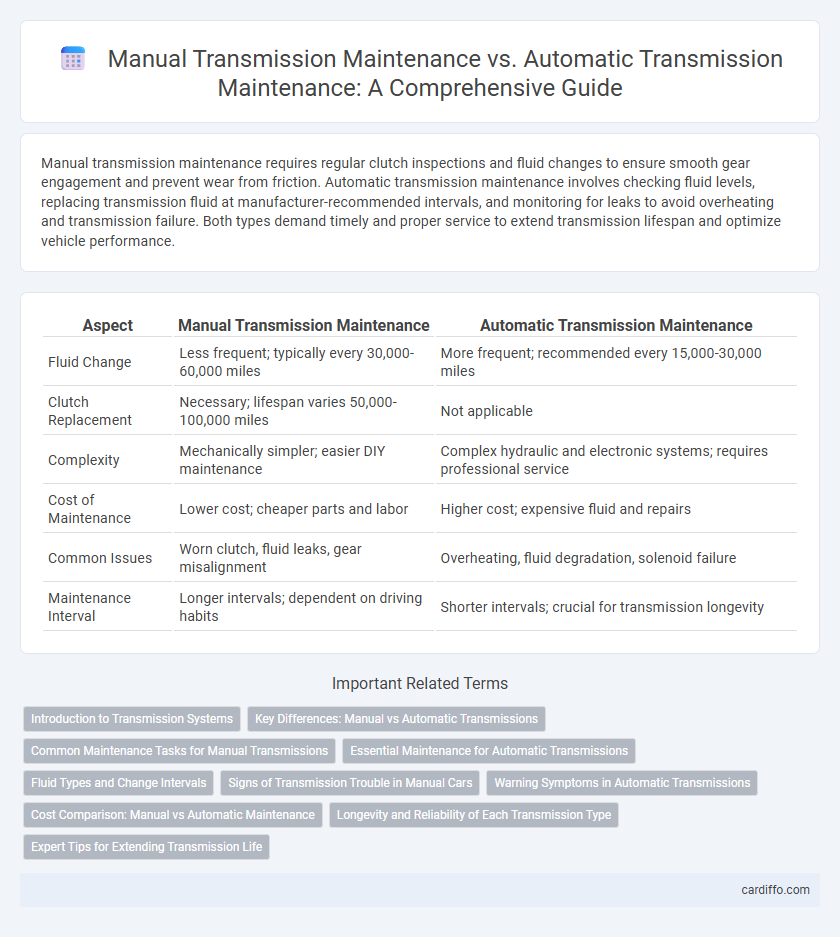Manual transmission maintenance requires regular clutch inspections and fluid changes to ensure smooth gear engagement and prevent wear from friction. Automatic transmission maintenance involves checking fluid levels, replacing transmission fluid at manufacturer-recommended intervals, and monitoring for leaks to avoid overheating and transmission failure. Both types demand timely and proper service to extend transmission lifespan and optimize vehicle performance.
Table of Comparison
| Aspect | Manual Transmission Maintenance | Automatic Transmission Maintenance |
|---|---|---|
| Fluid Change | Less frequent; typically every 30,000-60,000 miles | More frequent; recommended every 15,000-30,000 miles |
| Clutch Replacement | Necessary; lifespan varies 50,000-100,000 miles | Not applicable |
| Complexity | Mechanically simpler; easier DIY maintenance | Complex hydraulic and electronic systems; requires professional service |
| Cost of Maintenance | Lower cost; cheaper parts and labor | Higher cost; expensive fluid and repairs |
| Common Issues | Worn clutch, fluid leaks, gear misalignment | Overheating, fluid degradation, solenoid failure |
| Maintenance Interval | Longer intervals; dependent on driving habits | Shorter intervals; crucial for transmission longevity |
Introduction to Transmission Systems
Manual transmission maintenance involves regular clutch inspections, fluid changes, and adjustments to the linkage to ensure smooth gear shifts and prevent wear. Automatic transmission maintenance requires periodic fluid replacements, filter changes, and system diagnostics to avoid overheating and transmission slipping. Understanding the fundamental differences in mechanical complexity and maintenance schedules between manual and automatic transmissions is crucial for optimal vehicle performance and longevity.
Key Differences: Manual vs Automatic Transmissions
Manual transmission maintenance requires regular clutch inspections and adjustments due to the mechanical linkage and friction components involved, while automatic transmission maintenance focuses on fluid changes and computer system diagnostics to manage complex hydraulic systems. Manual gearboxes typically need more frequent checks of the clutch pedal and cable or linkage tension, whereas automatics rely heavily on transmission fluid quality and level for smooth operation and longevity. The key difference lies in manual systems' mechanical wear parts versus automatic systems' dependence on electronic control units and hydraulic pressure regulation for shifting performance.
Common Maintenance Tasks for Manual Transmissions
Manual transmission maintenance commonly involves regular clutch inspections, fluid changes, and checking linkage adjustments to ensure smooth gear shifts and prevent premature wear. Routine clutch fluid replacement and monitoring for leaks help maintain hydraulic systems, while gearbox oil changes reduce friction and extend the transmission's lifespan. Periodic inspection of the shift linkage and cables prevents misalignment and enhances overall shifting performance in manual transmission vehicles.
Essential Maintenance for Automatic Transmissions
Automatic transmission maintenance requires regular fluid changes to ensure smooth gear shifting and prevent overheating, which can damage the transmission system. Inspecting the transmission filter and pan for debris helps detect early signs of wear or contamination, preserving the longevity of components like clutches and bands. Performing periodic diagnostic checks with specialized scan tools reveals issues such as solenoid malfunctions or fluid pressure problems, essential for avoiding costly repairs.
Fluid Types and Change Intervals
Manual transmission maintenance requires using gear oil or manual transmission fluid (MTF) specially formulated to lubricate closely-meshed gears, with change intervals typically around every 30,000 to 60,000 miles depending on vehicle use. Automatic transmissions rely on automatic transmission fluid (ATF), which acts as a hydraulic fluid and lubricant, and often require fluid changes between 60,000 and 100,000 miles to prevent wear and maintain smooth shifting. Selecting the correct fluid type and adhering to manufacturer-recommended change intervals is crucial for prolonging transmission life and performance.
Signs of Transmission Trouble in Manual Cars
Signs of transmission trouble in manual cars include difficulty shifting gears, grinding noises when changing gears, and a burning smell indicating clutch wear. Slipping clutch or a soft, spongy clutch pedal often signal the need for immediate inspection to prevent further damage. Regular maintenance of the clutch system, transmission fluid levels, and linkages is essential to ensure smooth operation and longevity of manual transmissions.
Warning Symptoms in Automatic Transmissions
Automatic transmission warning symptoms include delayed shifting, slipping gears, and unusual noises such as whining or clunking sounds. Fluid leaks, overheating, and burnt transmission fluid odor often indicate internal damage requiring immediate attention. Ignoring these signs can lead to costly repairs or complete transmission failure.
Cost Comparison: Manual vs Automatic Maintenance
Manual transmission maintenance generally costs less than automatic transmission upkeep due to simpler mechanical components and fewer parts requiring regular service. Automatic transmissions involve complex hydraulic systems, electronic controls, and fluid changes, often leading to higher repair and maintenance expenses. Cost savings for manual transmissions can reach up to 30-40% compared to the frequent and costly service intervals associated with automatic transmissions.
Longevity and Reliability of Each Transmission Type
Manual transmission maintenance typically involves regular clutch adjustments and fluid changes, contributing to longer lifespan and greater mechanical reliability due to simpler design. Automatic transmissions require frequent fluid checks, filter replacements, and occasional software updates, which are critical for preventing costly failures and maintaining performance. Overall, manual transmissions tend to offer enhanced longevity and reliability when maintained properly, while automatic transmissions demand more complex, consistent upkeep to ensure durability.
Expert Tips for Extending Transmission Life
Manual transmission maintenance requires regular clutch inspections, fluid changes using manufacturer-recommended gear oil, and adjusting the linkage to prevent wear and ensure smooth gear shifts. Automatic transmission maintenance focuses on timely fluid and filter replacements with high-quality ATF, avoiding overheating by monitoring transmission temperature, and ensuring proper cooling system function. Expert tips emphasize following service schedules, using OEM parts, and addressing issues like slipping or delayed shifts promptly to extend transmission lifespan effectively.
Manual Transmission Maintenance vs Automatic Transmission Maintenance Infographic

 cardiffo.com
cardiffo.com